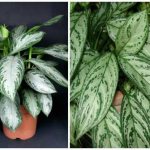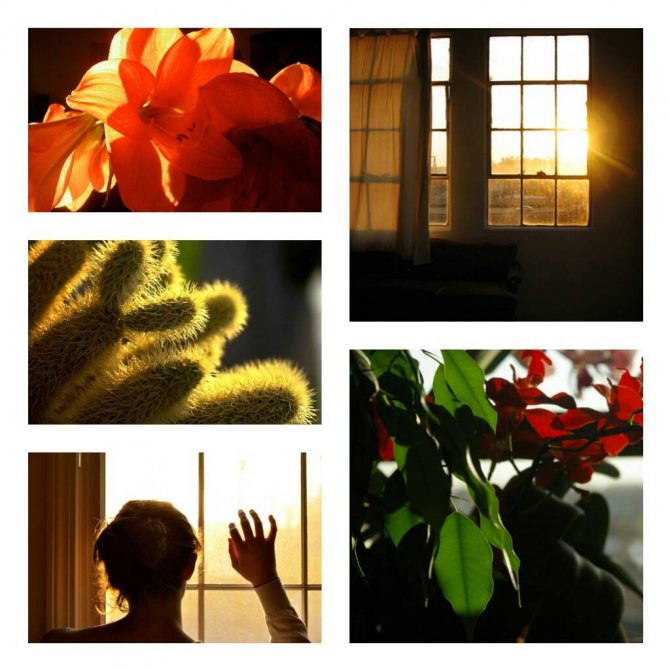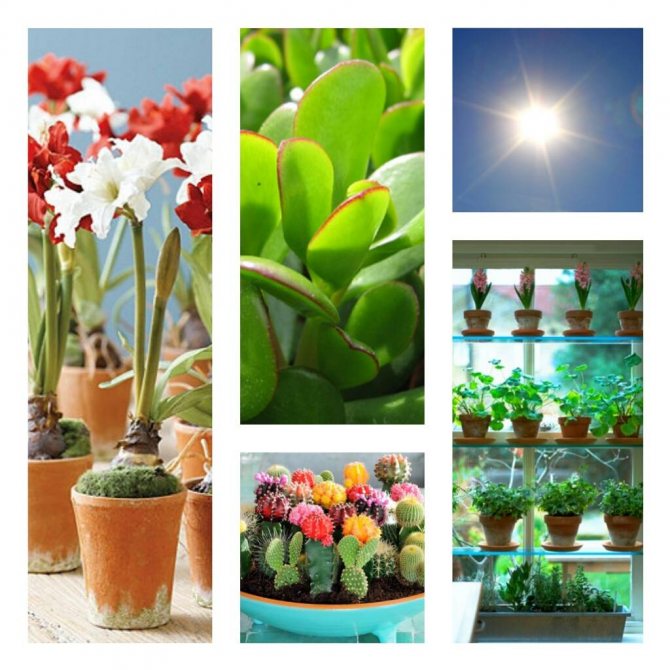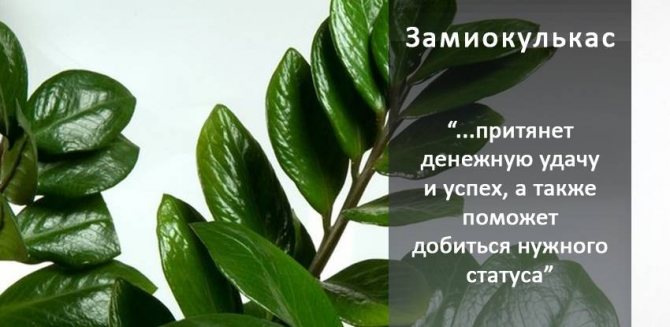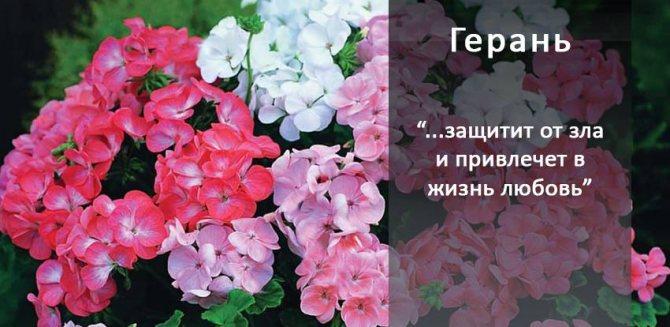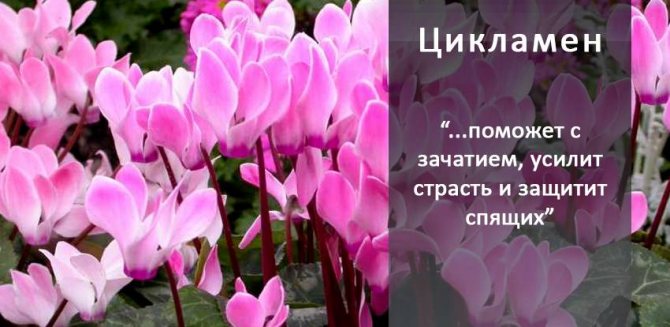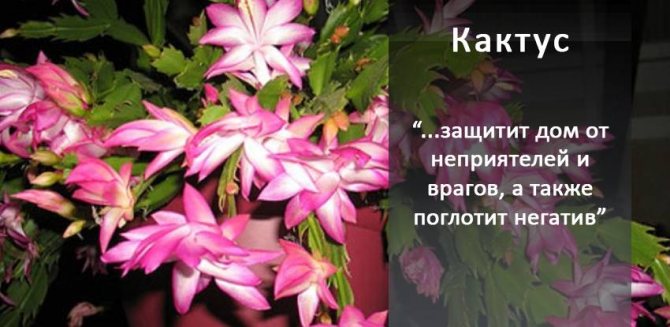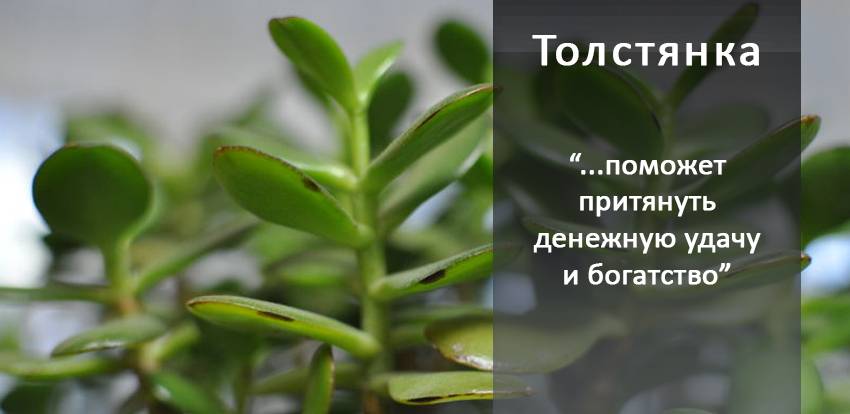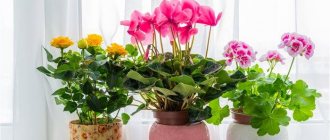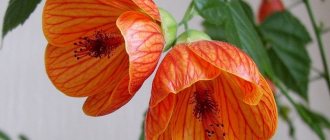Living landscaping can make any room more comfortable, because even the most unremarkable and small indoor plants can add their own touch of beauty and comfort. Apparently due to these properties, flowers in the bathroom, where there is no window, are very popular, although most of the plants are not able to grow fully without proper lighting. Most flower growers prefer spacious rooms with wide window sills, where seedlings or mature bushes are conveniently placed. There are varieties that prefer darkened areas, but unfortunately there are no plants that can grow and develop normally in complete darkness. But flower growers, lovers of decoration, are able to make a bathroom without windows a tropical paradise.
Decorative deciduous shade-loving plants
Any dark corner in the house can be decorated with plants with beautiful foliage, thereby bringing natural accents to the interior. To your attention a list of shade-loving indoor plants of decorative leafy type:
- Aglaonema stands out with fleshy short stalks, no more than 70 cm in height. The foliage is lanceolate and oblong, depending on the variety, the color can vary from green to variegated. Even though all aglaonema varieties tolerate shade well, the lack of light is best tolerated by specimens with green leaves. If the conditions are suitable for aglaonema, then it can throw out an ear with small flowers.
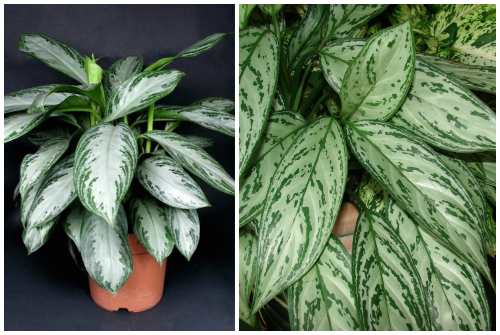
- Philodendron is a branchy creeping vine with beautiful dark green glossy leaves and airy roots. This specimen is the most unpretentious to light, but does not tolerate temperature changes, dry air and drafts. It is necessary to grow a philodendron in a large pot on the floor around the support, or in a hanging planter.


- Japanese fatsia is an evergreen shrub. Indoors, a shade-loving indoor flower is grown because of its unusual palmate, bright green, shiny and leathery leaves. The most popular are shade-tolerant variegated varieties with interesting colors, but the disadvantage is that they need a little more sun than green.
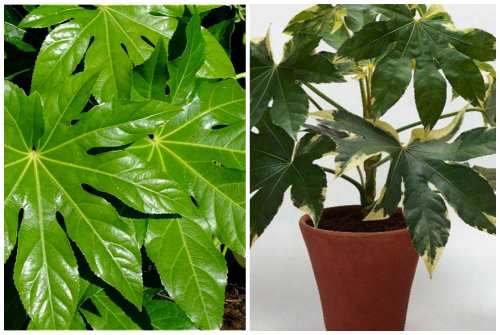

- Maidenhair is a representative of ferns. It stands out with thin creeping roots, because of which the plant was nicknamed "the Venus of the hair." On the stems there are opposite or alternate leaves with dark roots and scales near the base. Each leaf plate reaches 50 cm in width and 60 cm in length. Such varieties are perfect for the northern side of the room or for semi-dark corners.
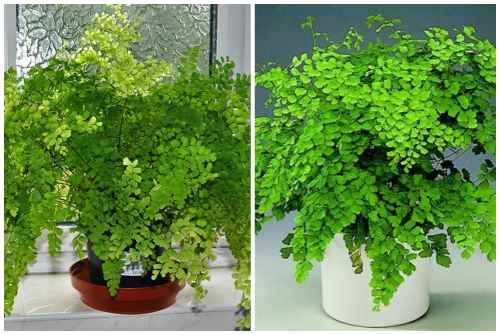

- Fatskhedera Lise is a hybrid of Japanese Fatsia and ivy. Its large palm-lobed foliage has a dark green color, and the total size can reach 3 m. Plants of this species do not like the sun, and they tolerate drafts well, therefore they are often chosen for the hallway.
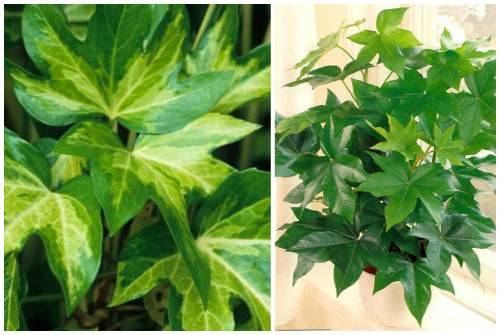

- Nephrolepis prefers partial shade, in such conditions it can grow up to three meters in diameter in 2-3 years. This bright representative of ferns stands out with small green leaves and stems growing in a bunch. Nephrolepis does not tolerate dry air, therefore it needs systematic spraying.
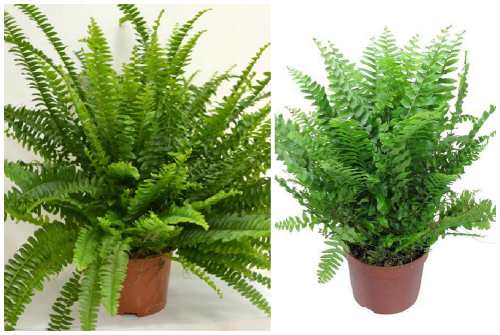

Lighting the bathroom correctly
For artificial lighting of the bathroom, you can use ordinary fluorescent lamps or special phytolamps.The latter are used by professional gardeners for lighting in greenhouses.
Installation of phytolamps is a more costly option, but they emit light with the desired frequency of colors, therefore, to a greater extent, they are able to compensate for sunlight.
When choosing a phytolamp, you should pay attention to the following varieties:
- Luminescent - they emit cold light, do not heat up and serve for a long time. The only negative is that flowers that prefer dim light should be placed at a distance of more than 50 cm from the lamps.
- Metal halide lamps - have a spectrum of radiation that is comfortable for any color, do not burn out for a long time, but are expensive.
A good solution would be to illuminate the bathroom with LED lamps. They emit soft, diffused light and allow flowers to be illuminated even in the most distant corners.


Palm plants and shade-tolerant large-sized plants
It is easy to decorate any secluded corner of a large room with the help of large pieces that do not like direct sunlight. Palm trees look good both alone and in an ensemble with other cultures.
- Unpretentious indoor plants that do not really need the sun are headed by a monstera. This is a fairly large flower, representing a liana. Its spreading, fan-shaped leaves with cuts can reach a length of up to 30 cm. The color can be green or variegated, and the height reaches several meters. One minus - weighty aerial roots, similar to ropes, which need support.
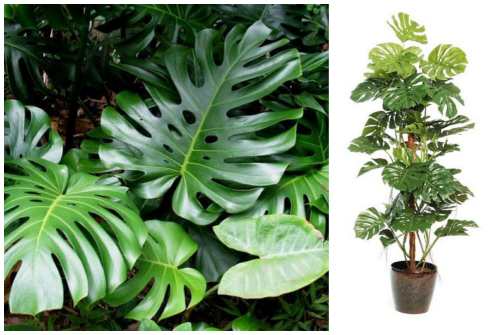

- Dracaena is an indoor tree plant with a gorgeous crown, consisting of thin or wide leaves. The second name of dracaena - "dragon tree" was acquired due to the unusual red juice it contains. In natural conditions, the height of the dracaena reaches 10 meters, but at home, growth slows down. Such specimens love shade, but they are just as comfortable in light rooms. The culture does not tolerate overflow, but responds well to spraying with water at room temperature.


- Ficuses of almost all types. The most shade-loving ones can be distinguished by the darkest color of the foliage. These cultures are often found in winter gardens, office buildings and spacious city apartments. Ficuses love moisture, spraying and partial shade, and their fleshy leaves should be regularly wiped with a damp sponge.


- Hamedorea is a slow growing palm tree. Many growers are familiar with the appearance of the palm tree. To maintain the beauty of the spreading crown, chamedorea should be systematically rinsed with a shower and protected from direct sunlight.


Benefit
It is important to remember that plants in a bathroom, where there is no window, not only carry an aesthetic message, but also bring undeniable benefits:
- in addition to the ability to release oxygen, thereby purifying the air, the flora in the bathroom prevents the formation of fungal formations, normalizes the microclimate, improves water and gas exchange, and absorbs microparticles of heavy metals;
- flowers with a natural aroma inherent in them deodorize the air of a room with or without a window;
- living indoor greenery is a pleasant reminder of summer, improves mood;
- flora plays an important role in the interior, making it colorful and complete.
From all of the above, the question arises: "can living vegetation grow normally and exist in a bathroom that has no windows - they can." There are varieties for which such conditions are the most acceptable and the absence of a window will not be an obstacle to enjoying their magnificent view every day.
Blooming shade-tolerant crops
As strange as it may sound, some brightly blooming crops grow well without an active sun, decorating rooms with a lack of lighting with color. They can be grown on windowsills on the north side or in a corner with an artificial lamp. Blooming shade-loving indoor plants can be chosen from a variety of options.For your attention the names with descriptions and photos.
- Clivia stands out favorably with unusual inflorescences in the form of umbrellas on high peduncles. Blooms profusely and brightly with light partial shade. Prefers fertile land and systematic watering.
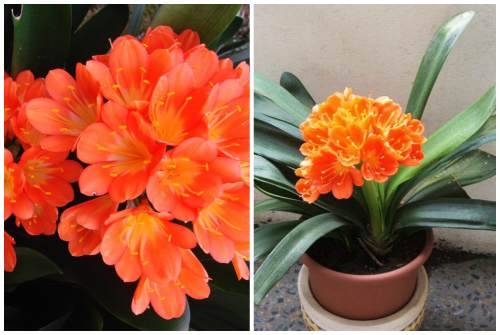

- Calathea Crocata is a relatively unpretentious culture with beautiful leaves of a dark green or light green shade with a speck or dash. In summer, flowers need watering and systematic spraying. Choose warm, draft-free rooms for them.


- Anthurium does not belong to unpretentious crops. Unusual, beautiful flowers give it a special charm. A green pet can delight the eye with white, red, pink, black or blue flowers. Water frequently in summer, and choose cool, draft-free rooms in winter.
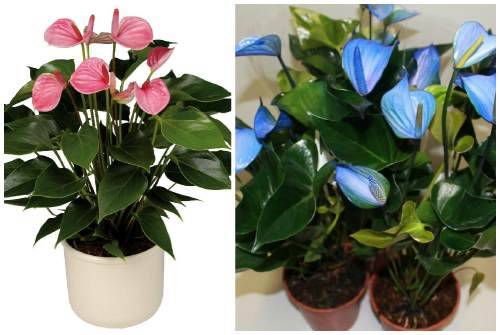

- Begonia is a flowering and shady culture. Bright color is able to please the owners at any time of the year. There are more than two thousand species of decorative deciduous and decorative blooming begonias. All options are undemanding to care.
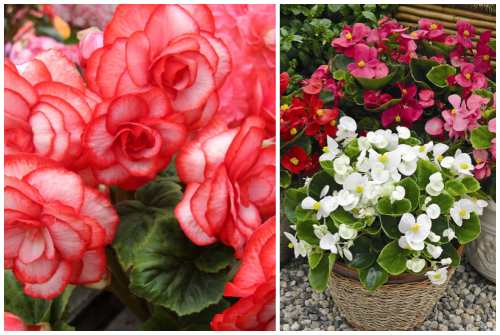

- Vriezia (Frizee) is ranked among bromeliads. Differs in a spike-shaped, beautiful and bright flower that blooms for more than 3 months. You can grow a Frizee at a temperature of +18 +27 degrees. In the process of watering, the soil is moistened, and a little liquid is poured into the outlet.
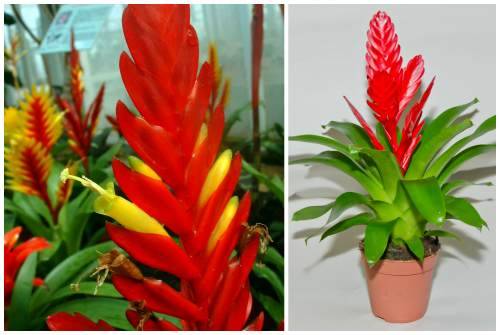

- Spathiphyllum is called “female happiness”. This species has beautiful, pointed leaves and sail-like white inflorescences. After a while, the surface of the flower turns green, and it is lost against the background of foliage. Pruning off wilting areas on a regular basis can help prolong the flowering period.
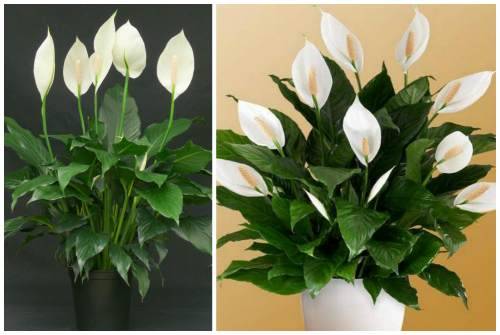

Pests must be dealt with
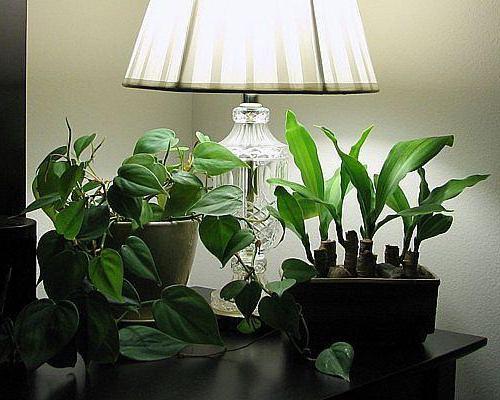

When wiping the leaves of shade-tolerant indoor plants from dust, you must carefully examine them for the presence of pests. For large-leaved, the danger is: spider mites and aphids.
The cobweb on the back of the leaves indicates that the plant is affected by a spider mite. This disease will lead to leaf fall. Therefore, it is necessary to fight this pest. If rubbing the leaves does not help, insecticides must be applied. As a preventive measure against spider mite damage to plants, air humidifiers or constant spraying of leaves are best suited. Because it is dry air that can cause damage to plants with this disease.
If you take good care of the plants, they will delight everyone with their beauty and help maintain a good climate in the house.
Curly shade-loving vines
Any bookcase, wall, wardrobe or flower stand can be successfully decorated with climbing vines.
- Ivy has star-shaped variegated or green leaves. In a very short time, it can grow and wrap around any kind of support. Cultivation is possible in a hanging planter or as an addition to a fur base to shape the tree.


- Scindapsus has leathery oval leaves. These leafy blades are decorated with yellow or white streaks. At home, vines grow quickly, and for beauty they must be systematically pruned. Loves humidity and abundant watering.
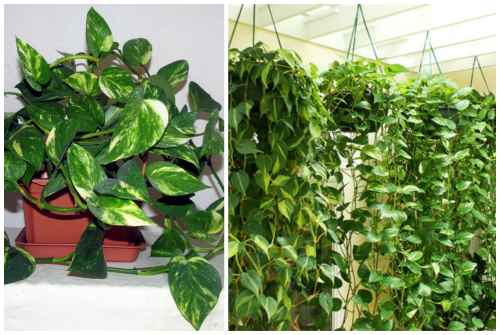

- Creeping callisia is an ampelous culture with ovoid, velvety leaves and creeping stems. They can be grown in hanging pots. Growing quickly, it creates a green carpet, so it is often planted in tubs next to large trees or used as filler in empty spaces in a composition.
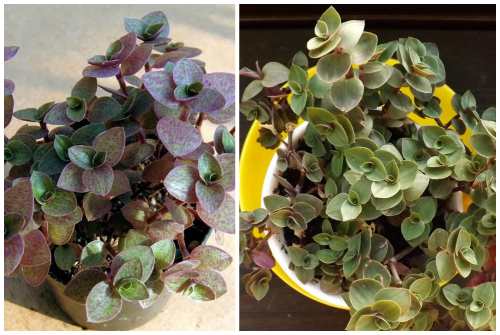

- Tradescantia has creeping shoots, elliptical foliage and axillary white inflorescences. For density, you need to pinch the Tradescantia.
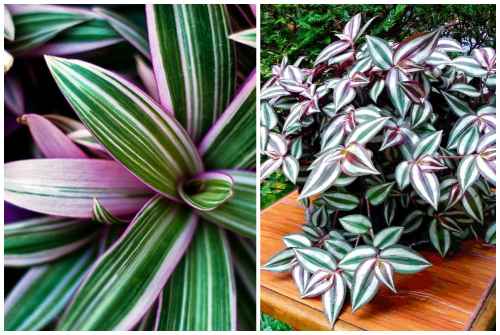

As you learned, even for the darkest rooms, you can pick up a small or large, decorative leafy or flowering plant. The right choice and competent care will help you enjoy your "green friend" all year round.
Aloe vera


In addition to a first aid kit, every home should have an extraordinary medicinal plant such as aloe vera.Its juice will heal minor cuts and burns, the plant is easily propagated by cuttings. Plant the aloe vera in a heavy ceramic pot that will promote good growth and air circulation. You can also add soil around the stem to provide support for new shoots.
Such plants feel good in diffused sunlight.
Asparagus, anthurium, azalea, royal begonia, grapes, bromeliads, dieffenbachia, dizigotene, zygocactus (Christmas), monstera, oxalis, columnea, penemeria, lily, scindapsus, philodendron, spathiphyllum, fuchsia, chlorophytum, schleflera. Such conditions are preferred by most ornamental deciduous and flowering plants. One of the brightest places in the apartment is the windowsill, although it's not bad nearby either. At the same time, it is necessary not to forget that at a distance of half a meter from the windowsill, the amount of light is 2 times less.
Care
The first way to create comfortable conditions for active growth is to install daylight or phytolamps. This is important given that the bathroom does not have a source of natural light and heat, like a window.
The second way to provide the flora with at least some kind of lighting is to take regular walks. In the daytime, they can be taken out where there will be plenty of light for them, and in the evening they can be brought back to their place. Watering should be moderate, as the soil in the pots dries up, it is better to spray.
Direct sunlight will not harm such representatives of home ornamental plants
Ginure, beloperone, zebrin, gloxinia, codiaum, capsicum, apical cordilina, kufei, nertera, touch-sensitive, sansevieria, poinsettia, streptocarchus, sencolia, tradescantia, chlorophytum, hoye, chrysanthemum, ficus.
Naturally, the listed not all plants, but only those that more often than others find themselves on the windowsill or just in apartments, both amateur gardeners and housewives. Plants need sunlight in the same way as air and water, but in moderation. This condition is essential for the normal development of a particular plant species. In this case, one should strictly adhere to the recommendations for caring for plants, as well as creating conditions for normal development, including ensuring the required amount of light. The plant can feel bad, both with a lack of light, and with its excess, and there is no need to talk about the effect of direct sunlight at all, since the plant can get burns. In this case, the result can be disastrous, and it is always difficult to start over.
Diffused light works best for this plant. It is best to keep it behind a curtain. The plant is especially beautiful in the spring-summer period, when light, delicate leaves appear in the center.
Dracaena marginata


This is a real slice of the tropics on the office desk. But keep the plant out of direct sunlight - they can damage them. The plant loves shade.
Chlorophytum crested
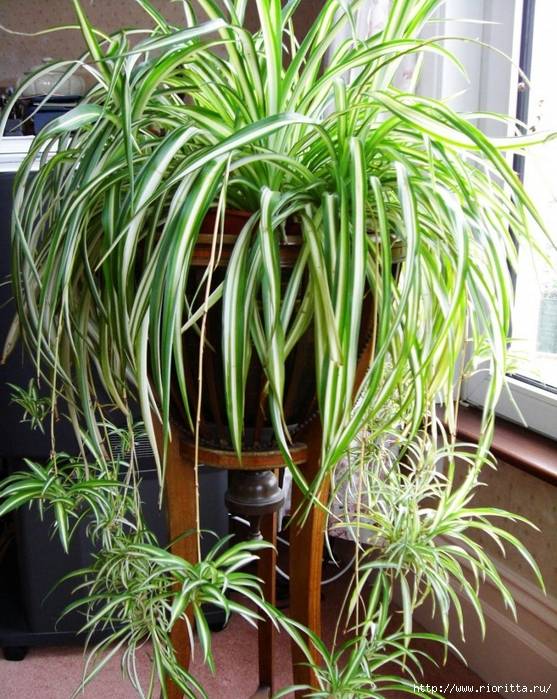

A very unpretentious plant, therefore, quite popular. It can go without the sun for a long time and at the same time perfectly purifies the air.
Gelksina


A plant with tiny delicate leaves looks beautiful in hanging pots and in pots next to tall plants. But be careful: do not plant it on low plants - gelksina can "strangle" them. Frequent watering and spraying is required of you.
Ferns
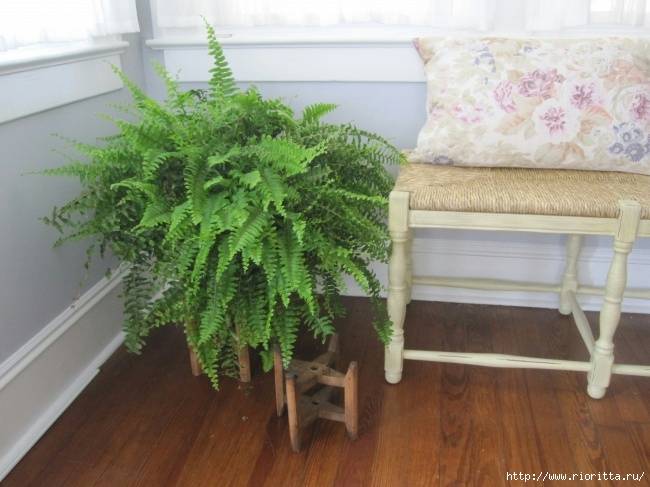

More than 2000 species of ferns are suitable for growing at home. These tropical plants are ready to stay in the shade, but they will not tolerate dry air. They need frequent spraying of the leaves, especially during the heating season.
Philodendron heart-shaped
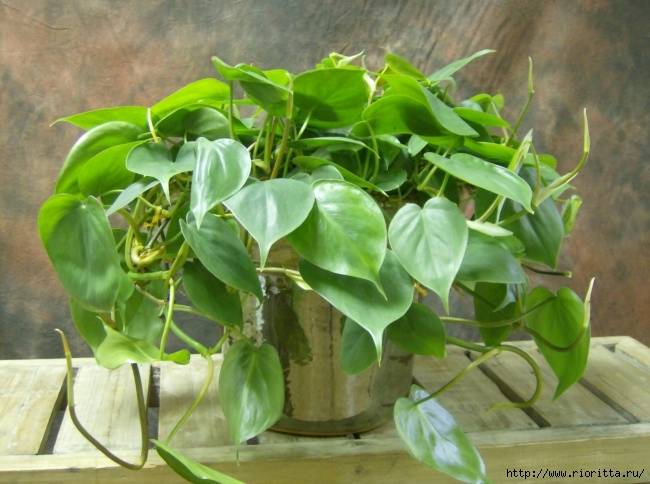

Perhaps this is a favorite plant of many flower growers. Feels good in the shade, perfectly cleans the air. Occasionally pinching is required so that it does not stretch too long.
Neoregelia
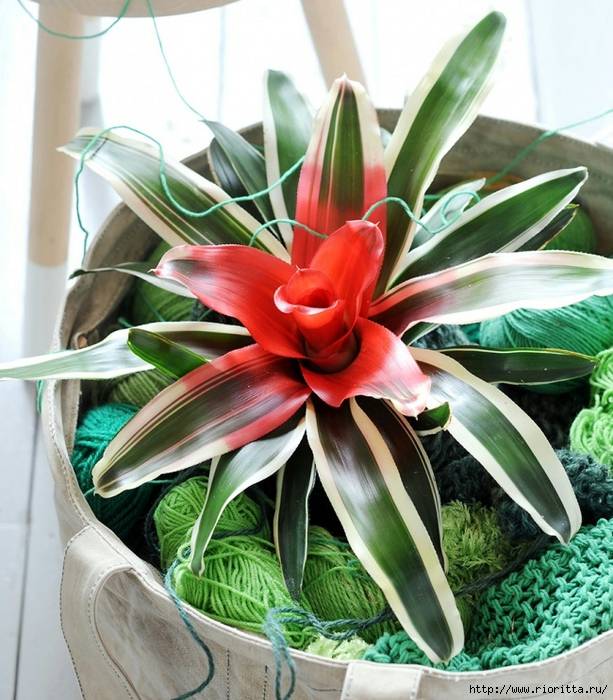

A tropical plant that thrives on artificial light only. It thrives in humid conditions such as bathrooms.
Spathiphyllum
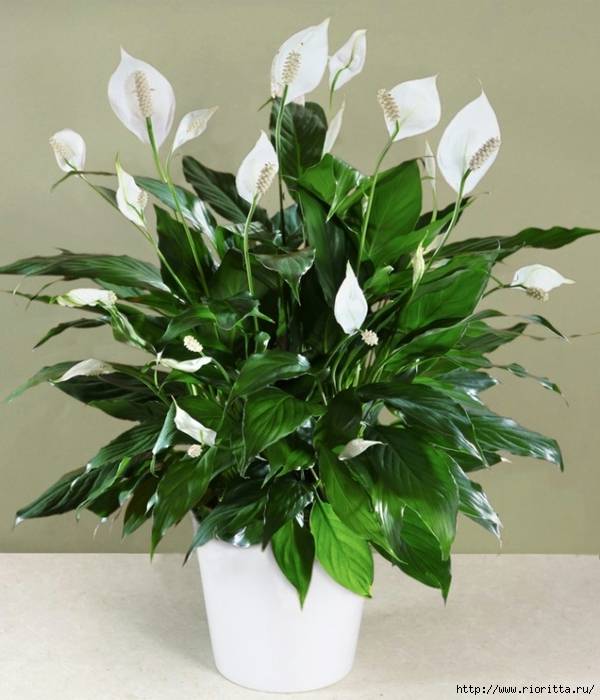

If you often forget to water your plants and almost no sunlight enters the room, you can pick up such a beautiful and unpretentious flower for yourself.
Aglaonema


One of the best choices for a low light room. Ideal for beginner gardeners.
Sansevieria three-lane
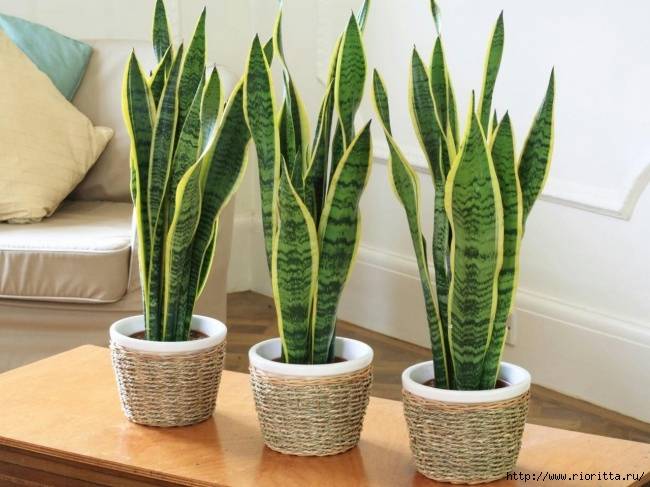

A plant that requires little or no maintenance. Light affects its growth, but it lives well in the dark.
Phalaenopsis is the most unpretentious orchid
by Bog L., photo by the author
It is no coincidence that Phalaenopsis is considered the most popular and unassuming orchid that successfully grows and blooms in the house.
In the title photo: the flowering of a white phalaenopsis, which lives in my office in a regular office.
Phalaenopsis are characterized by long stalks, on which beautiful flowers of various colors, with various combinations of patterns and patterns, bloom. This orchid got its Latin name (Phalaenopsis - "butterfly orchid") for the specific shape of the flowers: an unknown discoverer mistook them for a flock of bright butterflies ...
In stores, flowering phalaenopsis are sold out quickly, they are cheaper compared to other types of orchids. The experience of many other flower growers and my own examples confirm that phalaenopsis is really the most unpretentious orchid.
A selection of 12 plants that thrive in dimly lit rooms
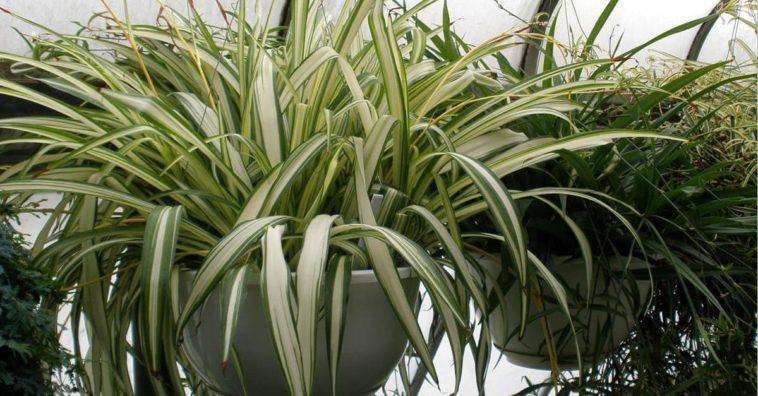

Today, the editors of Useful Tips will tell you about indoor plants that take root well in dark rooms and do not require special care. They will help to freshen the air in your home and will decorate every corner of it with charm inherent only in greenery.
What plants to choose for poorly lit rooms
1. Aglaonema
Aglaonema is a great choice for beginners. She is unpretentious and feels great in dark rooms.
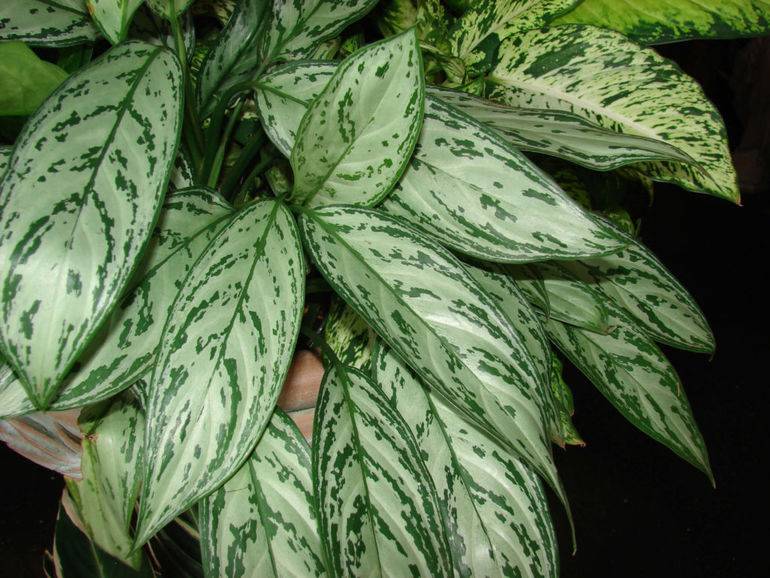

2. Aspidistra elatior
Resistant to shade, cold and heat, this plant will test your patience for only one reason - it develops more slowly than other plants.
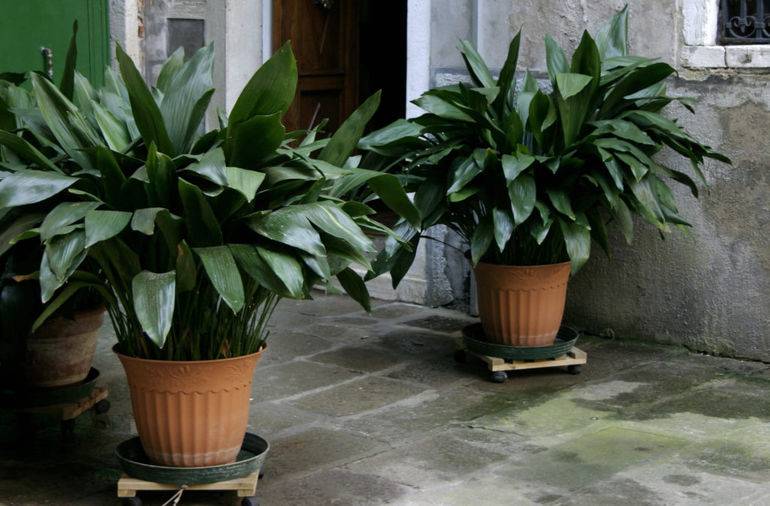

3. Calathea
Calathea will surprise you with a variety of leaf colors and become a chic home decoration. Due to the fact that this plant does not tolerate the sun, the best place for it would be rooms with poor natural lighting.
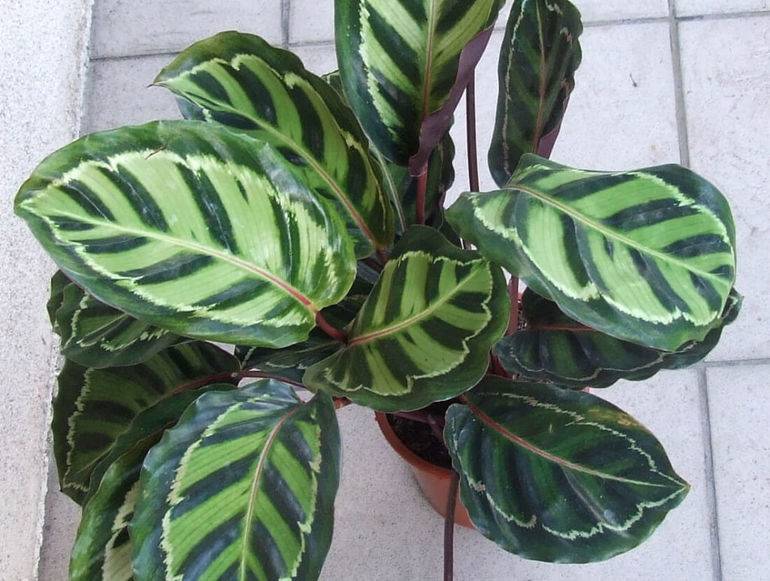

4. Chlorophytum comosum
This plant perfectly cleans the air, does not require a lot of light and special care. Therefore, it can often be found in apartments and public places.
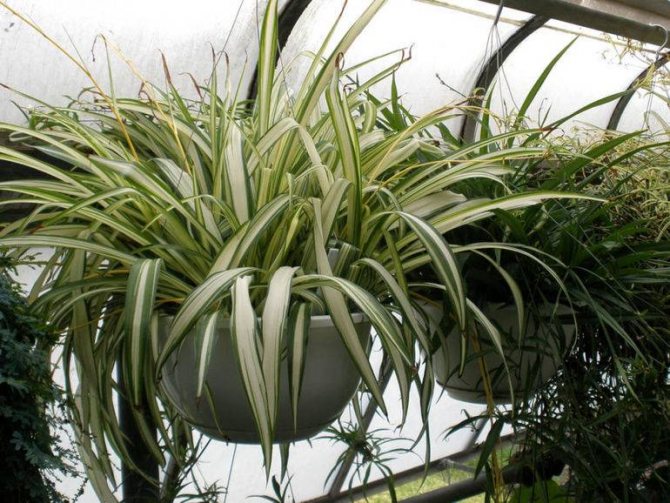

5. Dracaena
Despite the fact that dracaena resembles tropical palms, direct sunlight can simply burn its leaves. Therefore, place it where it will be protected from light.
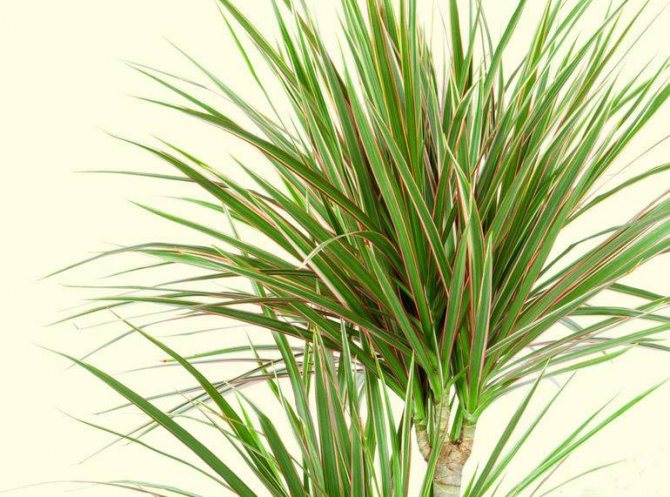

6. Dieffenbachia
Low maintenance, Dieffenbachia will beautify any interior. She does not require a lot of sunlight, so she survives perfectly even in rooms with closed curtains.
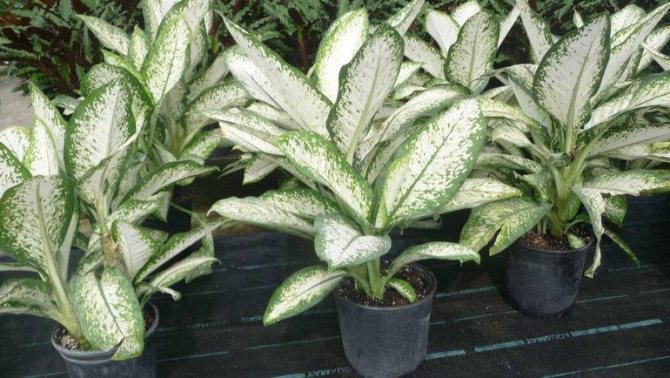

7. Neoregelia
This plant, belonging to the genus Bromeliads, is content with even artificial light, so it will be an excellent choice for the bathroom.


8. Philodendron cordatum
This plant has taken a special place in the hearts of gardeners. Probably because it gets along well in dark places and perfectly cleans the air. We recommend removing some of the leaves to speed up its growth.
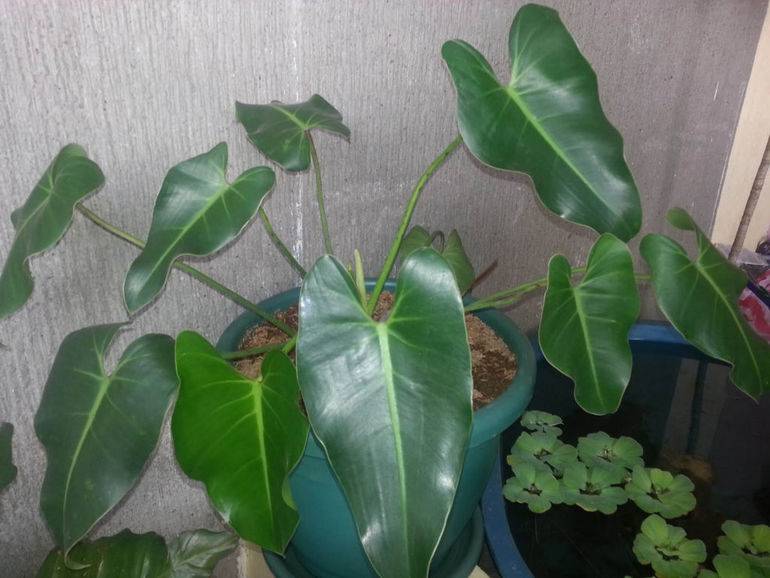

9. Fern
All fern plants will be a great solution for those who want to decorate rooms with poor lighting with plants. Unpretentious to sunlight, they need a lot of water. Therefore, water your ferns well and spray their leaves periodically so that they delight you with lush greenery.
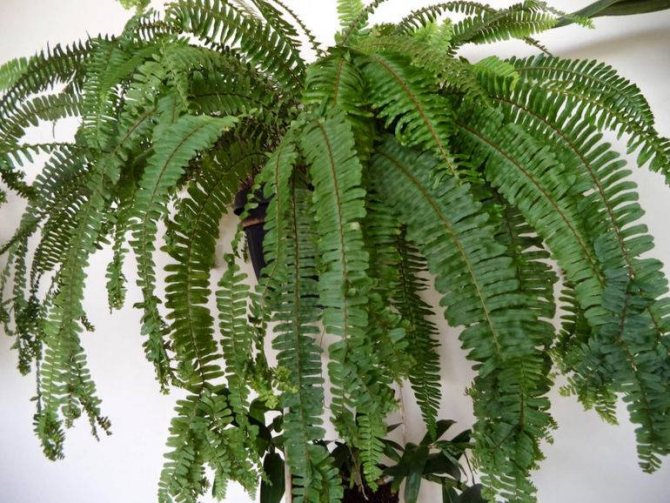

10.Sansevieria or Mother-in-law Language
A very unpretentious sansevieria cannot be scared by the darkness. Perhaps that is why she was so invited to lovers of indoor plants.
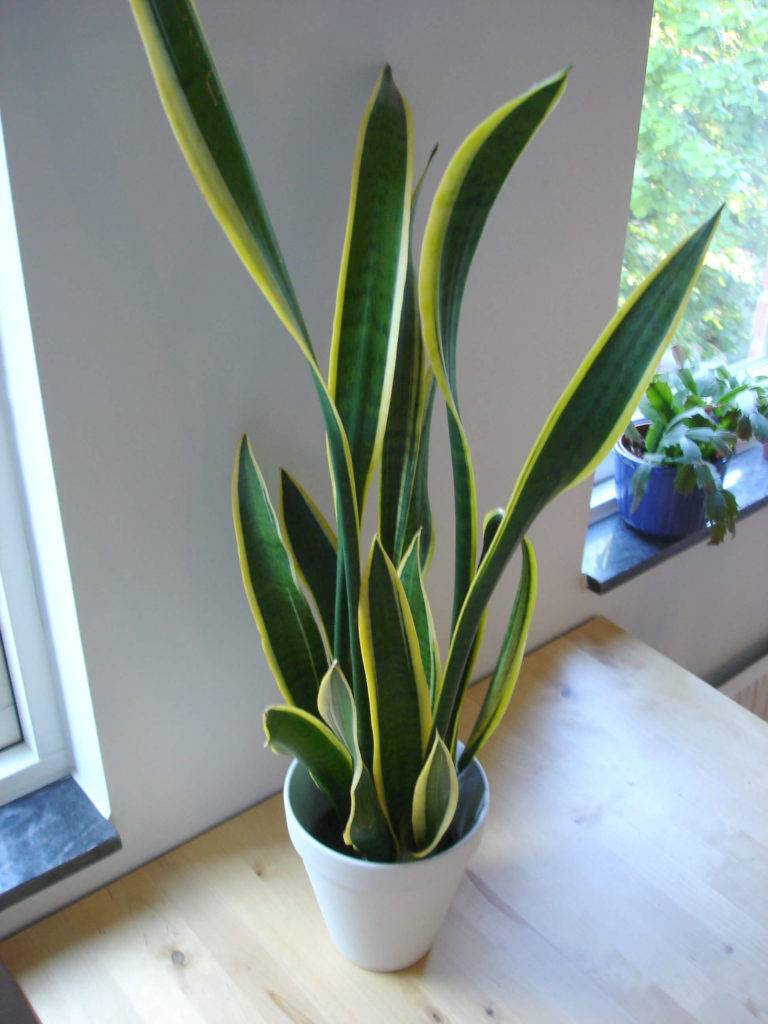

11. Soleirolia soleirolii
This plant is called "children's tears" due to its small leaves. It needs a lot of water, so we do not recommend planting it in the same pot with other plants.
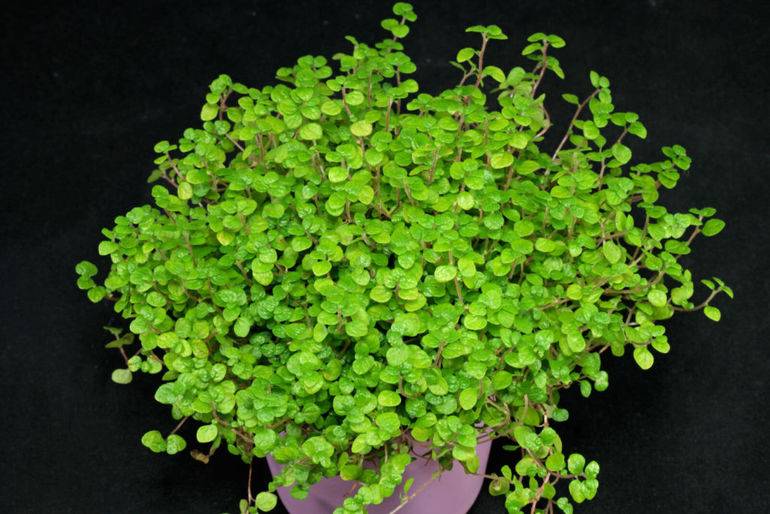

12. Spathiphyllum
Spathiphyllum is unpretentious in care, does not require direct sunlight or regular watering. Therefore, it will pleasantly surprise those who often forget to water their indoor plants.
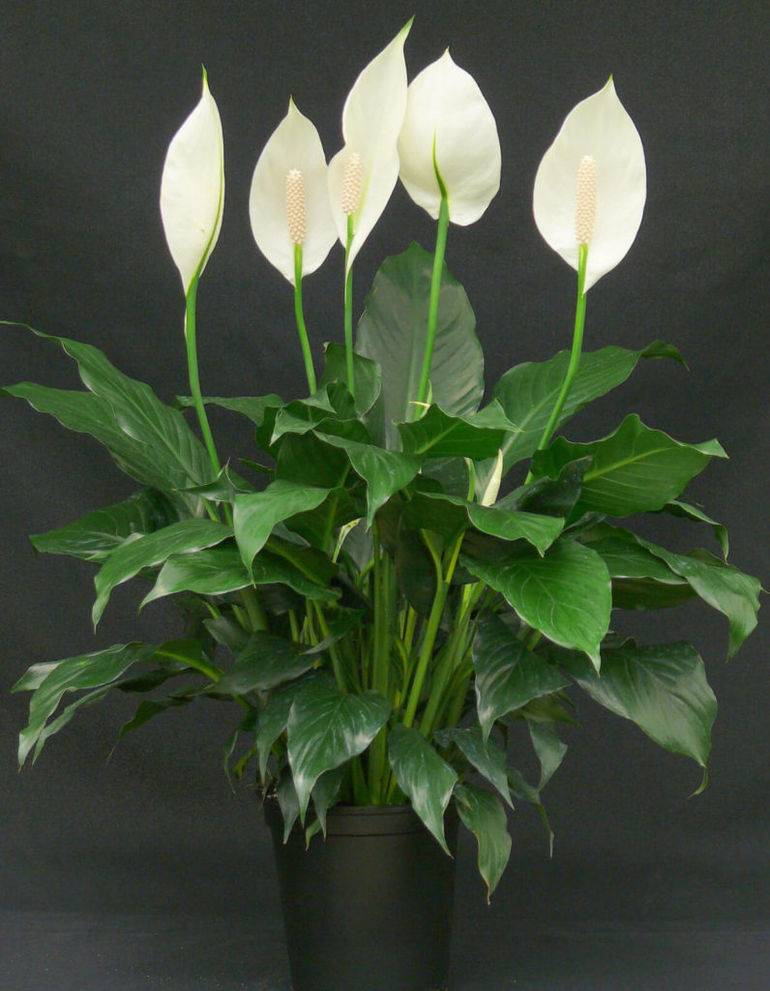

Watch the video and learn more about plants that don't require a lot of sunlight to grow fully.
published on according to the materials
cemicvet.


What colors don't need sunlight
Absolutely all flowers and plants need sunlight, warmth and moisture. The only difference is that some flowers become more beautiful, being under the scorching sun. Other varieties feel great in darkened rooms, where rays of light rarely enter. What flowers do not need sunlight Instruction 1 Lily Spathiphyllum is the scientific name for lilies. The beautiful plant with white flowers and shiny dark green leaves prefers the shady side of the room. And the presence of yellow spots-burns on the leaves of the lily indicates that she is receiving more light than is required. Little light, but a lot of moisture is the secret to the growth and beauty of the spathiphyllum flower. 2 Zygocactus In many countries around the world, this flower is known as the Christmas cactus, as it blooms during the winter holidays. These flowers are rather picky about both light and temperature and humidity. They are able to withstand temperatures from 2 ° C to 38 ° C, but they feel better in the range 18 ° C - 30 ° C. Zygocactus are rich in a variety of colors and shapes. Besides the traditional red and white flowers, there are lavender, peach, yellow and orange flowers. This plant blooms beautifully in pots and hanging baskets. 3 Saxifrage A small plant from 5 to 50 cm in height pleases the eye with cheerful flowers and dense leaves of regular shape. There are over 370 species of these flowers, and they all tend to grow in dense thickets with jagged leaves. Flowers differ in a variety of shades and shapes - from bright yellow on short stalks to purple and purple on creeping stems. 4 Arrowroot A small plant up to 20 cm in height has large green leaves with large brown veins in the middle and small white flowers 2-3 in inflorescence. Arrowroot is sensitive to direct sunlight, as well as drafts and temperature changes. Requires abundant watering, as well as frequent feeding in the spring and summer. 5 Cineraria There is a wide variety of hybrid forms of cineraria. The most popular species have large, round leaves resembling burdocks and double, semi-double, or simple daisy-like flowers. Depending on the variety, cineraria reaches a height of 25-70 cm, and the flowers have different colors: blue, lilac, pink, orange, red and other colors. Yellow cineraria never occurs. 6 Violet or Saintpaulia is a favorite plant of many flower beds. They delight with a variety of colors, leaves and shapes. Violets do not tolerate sudden changes in temperature and drafts. They do not require bright sun, but the illumination should be uniform from all directions, so the flower can be periodically rotated on the window. Thanks to the use of artificial lighting, the violet can bloom all year round.
Choice of colors
The following plants should be considered as an addition to the interior of the bathroom:
- Large (fatsia, attractive monstera);
- Curly (philodendron, epipremnum);
- Shrub (hamedorea, aglaonema);
- Blooming (violets, Decembrists, chrysanthemums).
If the size of the room allows, then you may like a fern, ficus or hovea.These flowers are quite large, but they look great. Plus, they get along easily under the conditions of detention in the bathroom.
Without windows and phytolamps
The likelihood of meeting a window in the bathroom, as we have already said, is rather small. Plus, not everyone wants or can install phytolamps. And I want to see flowers inside this room. What should be done in this case?
In fact, we can offer three options.
- Use fresh, cut flowers. Place small bouquets in vases near a mirror, on shelves, counters, and a washing machine. If you have your own garden, or there are no problems with access to flowers, you can change the decor once a week. The presence of beautiful colors makes serious changes in the perception of the interior.
- Consider using artificial flowers. Not all of them are perceived properly, associating with certain events. Nevertheless, with the help of artificial plants, you can create magnificent decorations, hide unsightly communications, and disguise cracks that have appeared on the walls. Most importantly, they do not need to be looked after. Quality artificial flowers look great, they are a copy of living plants.
- Do not discount dried flowers. They can also be used to perfectly decorate the interior. But keep in mind that it is better to immediately treat such plants with moisture-protective compounds, otherwise they may begin to decay over time.
Location options
So, you decided to put flowers at your place, decorating the bathroom with them. But here a completely natural question arises - where to put them. Indeed, the bathroom is not a window sill that can be completely covered with flowerpots. Plus, not in every zone, flowers will be appropriate. They can simply get in the way under the arms and legs. Therefore, it is necessary to choose the optimal places where the flowers will decorate the room and not cause discomfort.
Floor. Large, tree-like plants, tall dried flowers or large bouquets of fresh flowers can be placed on the floor. It is best to choose empty corners for this, where you perform a minimum of actions. For example, many have one of the corners of the bathroom allocated for the placement of basins or pots; Window sill. Rare, but still an option. Besides, it is quite possible to create an imitation of a window. Many people install decorative frames with a window sill, creating the effect of a real window. So why not bring it even closer to the present by installing a few plants; Shelves. If you have opted for small, climbing plants, then the shelves will be the best place to place them. Choose such a height of their location so as not to cause discomfort to you. Experimenting with their location is a pleasure for those who like to decorate a room. Ladder, chess principle, steps and so on; Racks and bedside tables. Someone buys spacious furniture and half of the space is empty. So it is quite possible to occupy it with flowers. Some people specifically buy separate stands dedicated specifically for landscaping the room.
Here, as you know, it is important to have an impressive bathroom area; Cabinets. If you are unable to allocate shelves for flowers, then you can use the space on the wall cabinets.
At the same time, it is advisable not to put them under the very ceiling, otherwise leaving will cause you a lot of trouble.
Well, plants in the bathroom have every right to be placed. However, certain conditions must be met to achieve the desired result.
First of all, you must pick those flowers that will not wither after a couple of weeks. You also need to create conditions for maintaining the life and development of flowers. Keep in mind that even the most resilient plantings have their limits. And, of course, without proper care, the flower will disappear.
So act wisely and carefully. Plants should make you happy and enjoyable. Otherwise, there is no point in landscaping the bathroom.
Croton
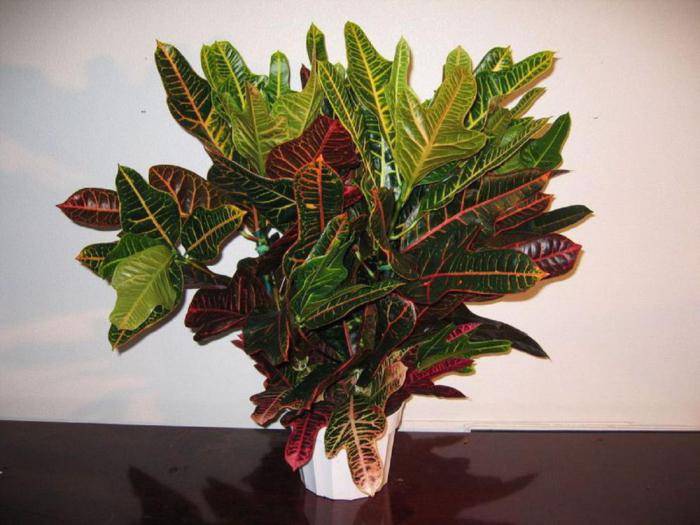

Croton is proof that foliage can be much more beautiful and brighter than flowers. Don't overdo it with watering. Only do this when the soil surface appears dry. Croton is a plant that needs warm temperatures, then it will grow and delight you with its appearance. However, if the air temperature drops below 15 ° C, the plant begins to disappear.
Spathiphyllum
This plant came to us from the tropical forests of America, Venezuela, Brazil, Colombia, and the Philippine Islands.
The flower loves to be in partial shade at a temperature of 18-25 degrees. likes high humidity, however, this does not mean that it needs to be fanatically watered. Watering should be done when the soil begins to dry out. The flower loves to be sprinkled with warm water, but at the same time you need to make sure that the water does not get into the cobs. To create a humid environment around the pot, you can use trays of moss or sand and water to gradually evaporate the moisture.
A young plant can be replanted every spring by adding brick chips or charcoal to the soil. But it is better not to disturb an adult plant for 3-5 years.
Nolina
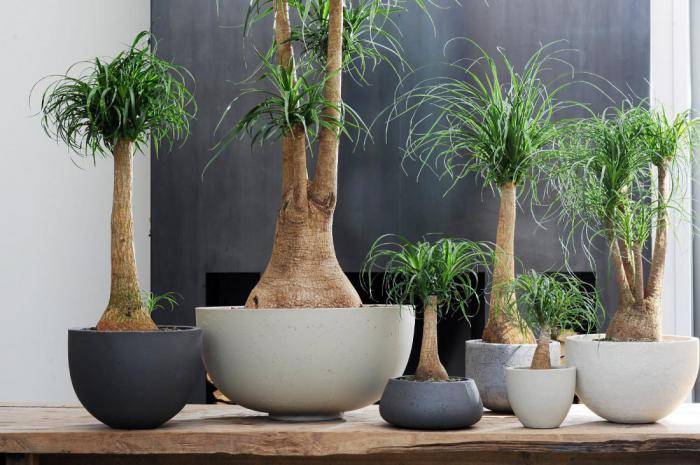

A swollen, thick trunk and curly foliage. This is a kind of plant that is ideal for growing in a corner in a sunny kitchen or living room. A plant that does not need special care is just right for lazy people. All you need to do is plant it in a large ceramic pot and water it once a week. Nolina grows slowly and only needs a transplant once a year or two.
Accommodation features
In order for plants for a bathroom without windows to feel comfortable, you need to find a suitable place for them. The interior of the room will also benefit from this.
- Plants with lush spreading greenery look good on special stands or pedestals. They can be the same color as the walls or have a contrasting shade.
- If the bathroom is small, ampelous plant species located on cabinets or shelves look very impressive.
- In a large room, you can arrange flowers in large pots right on the floor. And so that they do not interfere with free movement, they should be placed to the side or in a corner.


- A washing machine is not the best option for placing green spaces on it.
- Hanging pots will help out if the bathtub is small. They can be arranged randomly or staggered.
- Hanging flowers that frame the mirror on both sides look very effective. To do this, you need to nail a shelf at the top and put plants there.
- To enhance and emphasize the originality of the interior, you can use pots of the same shape, but different in color and size.
It is not recommended to place plant pots next to a sink, shower or bathtub. First, they will interfere there. Secondly, they can be splashed with water or detergents. As a result, the flower may die.
Also, don't put flowers close to heat sources. This will cause the leaves to dry out.
Drooping cycad
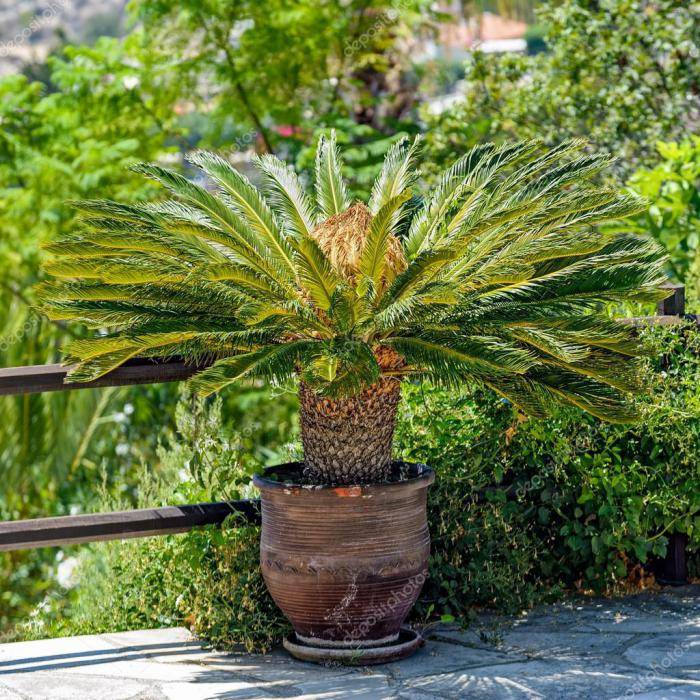

The handsome evergreen Cygovnik grows very slowly and fits perfectly into modern home decors. It does not bloom and rarely sheds its leaves, which makes it the perfect neat houseplant for both the bedroom and living room. Do you have any pets? This plant is very poisonous and can harm your pets.
Papyrus
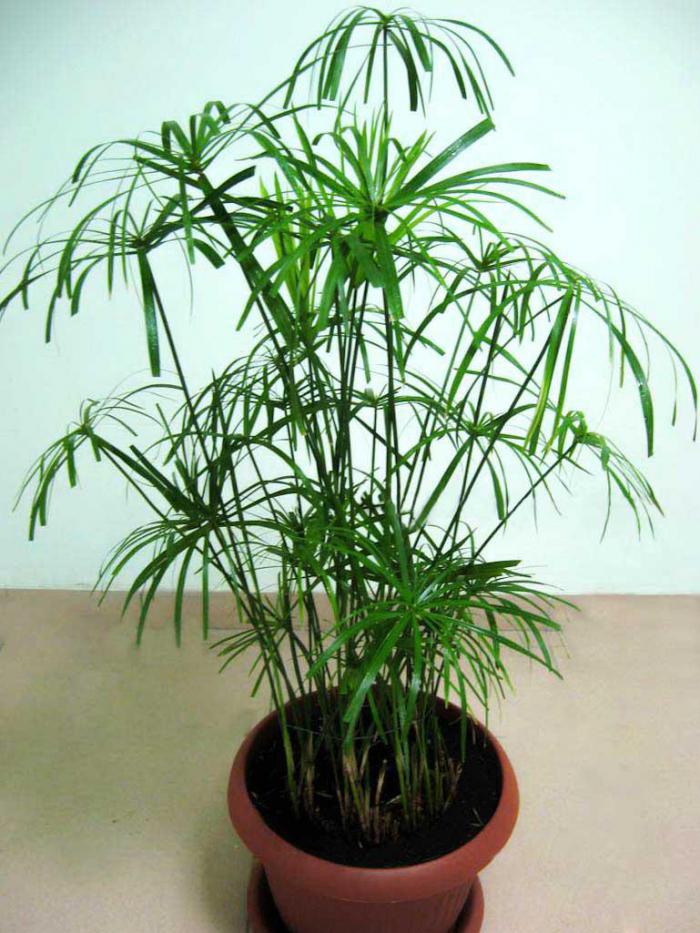

It turns out that the papyrus, from which the Egyptians built boats and made paper, is an interesting type of houseplant. The most important thing is to water it in a timely manner. This is the plant that loves moisture the most. Place the pot with it in a stand of water and change the liquid weekly so that it does not stagnate.
The couple arranged a wedding by recreating scenes from the movie "Back to the Future"
3 days in a house in nature made you understand what the real values are
The husband spent a long time with friends, and his wife built his own pub in the garden
For kitchen
You can decorate the kitchen space with the following flowers:
- The money tree symbolizes the wealth and well-being of the family. It is distinguished by thick leaves and glossy color. This is an ideal floristic option for the kitchen.
- Violet.
- Begonia.
- Croton.
- Scheffler.
- Fruit trees. These mini-trees have a sophisticated aroma and attractive appearance. They help neutralize kitchen odors.
- Calathea. The peculiarity of calathea is its increased resistance to moisture.
- Balsam.
- Zebrina.
It is worth remembering that when decorating a kitchen space, it is forbidden to place flowerpots and pots next to heating objects, a stove, a sink or a hood.
List of links of all bookmakers
Hello everybody! Today on the women's site we will talk about indoor plants that do not require light.
Most of the indoor plants found their way into our homes from regions with tropical or subtropical climates. For normal development, they need intense lighting. But along with them there are also indoor plants that do not require light.
Ferns are one of the most popular plants in our country. In nature, they grow in the shade of large trees, so they do not need bright sunlight at all. The most common among amateur flower growers are such plants from the fern family as Nephrolepis, Adiantum hair Venus, Polypodium.
Indoor plants that do not require light and maintenance
Nephrolepis - the most unpretentious of all ferns to care for. It can also be grown indoors without heating. In general, all ferns require partial shade and cool air.
It is best to plant them in soil consisting of humus, sand and leafy soil. Watering should be regular, and spraying is a prerequisite in the heat.
Indoor plants that do not require light and care. (sansevieria)
A plant is also suitable for placement in partial shade. Sansevieria (also called the Indian sword or Pike tail). It does not require special care, but it develops well both in cool and in heat, with dry or humid air. The flower will not disappear even with regular drying out of the soil.
Sansevieria has a weak root system and thick, fleshy leaves. Excessive watering and stagnant moisture can harm the plant. Before planting, the soil must be loosened well and humus and sand must be added to the leafy soil.
For information, Sansevieria is a Sagittarius plant.
Almost all indoor plants that do not require light do not need special care.
Indoor plants that do not require light and care. (cirtomium)
Cyrtomium Sickle - a plant that is perfect for novice growers, since it is almost impossible to spoil it.
It easily tolerates cold, it can be kept even on the balcony in winter, the main thing is that the temperature is not lower than 0 ° C.
This fern can tolerate dry air and even drafts, so it is worth purchasing.
The cyrthomium should be watered moderately. If you periodically forget about watering, it will only benefit the plant. It is worth noting that in the spring and summer period, at least once a month, the flower needs rainwatering.
This means that the plant needs to be irrigated with water. To do this, put the pot in the bathroom, and water it for a short time from the shower.
Indoor plants that do not require light and care. (aspidistra)
Aspidistra or A friendly family - a shade-tolerant plant that came to us from the forests of East Asia. In England, Aspidistra received the name "cast iron plant" because of its unpretentiousness.
In forest areas, it grows in highly shaded areas, so it is necessary to choose a place for it indoors, where there is practically no sunlight.
This flower does not need special care - Aspidistra is not demanding either for special watering or for a specific composition of the soil.
The Flower Friendly Family has dark green leaves that grow beautifully even in dry and dusty air.
The flowers of the plant look like fish scales and are dark brown in color. They grow close to the ground, so you may not immediately notice them.
As an addition to this wonderful plant, it must be said that this is one of the few plants that can be placed in children's rooms. Follow the link and read an article on this topic, if interested.
Indoor plants that do not require bright sunlight can perfectly decorate the walls of a home.
These include ordinary ivy... It is important to know that the variety of ivy, which has variegated leaves, still requires more intense light than its "relatives". And yet, with a lack of it, the plant will not disappear, just the leaves of the flower will acquire a darker shade of green.
If interested, I can offer an article about ivy as a plant of the Gemini zodiac sign, where you can learn about the influence of this plant on human energy. Follow the link.
You can find out more about how to care for, propagate ivy, about diseases and pests on my page. Follow the link, it will be interesting!
Indoor plants that do not require light and care. Photo. (chlorophytum)
Another unpretentious plant - Chlorophytum... He prefers diffused bright light, but he will be able to withstand a little shade, while turning pale in color. But irregular watering of chlorophytum on the shoulder.
For planting, you will need loose and fertile soil. If the plant is watered from time to time, you need to make sure that it is abundant. During the heating season, Chlorophytum needs periodic spraying.
Indoor plants that do not require light and care. Photo. (Clivia)
For lovers of flowering indoor plants that do not require special lighting, a flower with the name is suitable Clivia... She will decorate the room with luxuriously beautiful leaves of dark green color and no less beautiful bright flowers.
The flowers of the plant are collected in lush, umbrella-shaped inflorescences. The number of flowers in one inflorescence can reach 20 pieces. Clivia needs fertile soil, and in the summer season - abundant watering.
Astrologically, Clivia is a Sagittarius plant and influences the energy of people in its own way.
Indoor plants that do not require light and care. Photo. (maranta)
All flowers of the family are also a popular shade plant. arrowroot.
They easily tolerate darkening, even, rather, prefer shade.
Due to the intense light, the surface of their leaves is destroyed, leaving burns.
Arrowroot, for example, can grow fully under artificial lighting. The leaves of this plant are rounded, in some cases with pointed ends.
Caring for Maranta is completely uncomplicated. First, you need to determine the location of the flower, the temperature conditions of which do not exceed 16 ° C. It is necessary to water the plant about 2 times a week - it all depends on the room conditions.
About the energetic influence of arrowroot as a plant of the sign of Aquarius in an article on this topic. Also, Maranta is perfect for interior decoration, more on this at this link.
Weak lighting is also well tolerated by representatives of the Aroid family (Dieffenbachia, Syngonium, Philodendron, Anthurium, Alocasia, Aglaonema, Spathiphyllum.Monstera, Scindapsus, Alocasia, etc.). In the summer, they are provided with diffused lighting, in winter, you can remove the plant in a dark place in the apartment.
For indoor plants that do not require bright light - lighting, also include Bromeliads, Ficus, most types of palms, Tsiperus, Cissus, Dracaena.
Dracaena of different types belong to plants of different signs of the zodiac.For example, Dracaena Dragon is a Scorpion plant; Dracaena unbent - Virgo plant; Dracaena Godsef - Aquarius plant; Dracaena deremskaya and Dracaena fragrant is a Capricorn plant. Follow the links, there is a lot of interesting information about the influence of plants on human energy and their photos are presented.
Of course, as lovers of indoor plants, you will need knowledge of how to transplant indoor plants. Professionals will share this with you. Follow the link, you are welcome.
Synadenium


Triangular spurge (synadenium) is a perennial shrub that causes many people to immediately either have a strong feeling of affection or dislike. Although not a cactus, this plant has sharp thorns that can hurt you. Triangular spurge is a strictly tropical plant. And if in the summer it will stand in your open air, be sure to monitor the temperature. As soon as it drops to 10 ° C, you will have to bring it into a warm room.
Room temperature requirements
In a residential area, it is now possible to grow plants that originally grow in the desert, near water bodies, in an open space. This requires compliance with certain conditions of detention, which are maximally adapted for existence in the natural environment.
The plant, chosen taking into account the characteristics of the room, will delight you with beauty and health, as well as a minimum of effort and means for caring for it. The decisive factor is the choice of the plant, taking into account the appropriate temperature regime, ensuring periods of dormancy and growth.
Depending on this indicator, indoor flowers are divided into three groups:
- Moderately thermophilic - grow favorably at 14-17 ° C. These include aloe, asparagus, clivia, zebrina, zygocactus, Kalanchoe, tradescantia, ivy, cyperus.
- Heat-loving - feel great at 18 - 25 ° C and suffer from the slightest decrease in degrees. Their root system does not absorb air well and rots. These are tropical plants: begonia, peperomia, saintpaulia, coleus, bromeliad. When the air temperature rises above 28 ° C, they also feel bad: the leaves darken, wither, fall off. It is important to ensure sufficient air humidity.
- Cold-resistant - oleander, date, raucaria, clivia, yucca, chlorophytum, cyclamen - thrive at 10 -15 ° C.
Each houseplant has a temperature limit, when lowering which they die. For example, for akalifa, anthurium, dieffenbachia, syngonium - it is 14 ° С, begonias, Kalanchoe, orchids - not lower than 10 ° С, and pelargonium, ivy, tradescantia, saxifrage are preserved at temperatures up to 5 ° С.
In winter, it is important to provide rest for flowers by reducing watering and maintaining a thermal regime of 10 to 4 ° C. Therefore, when choosing a suitable plant, take into account the temperature regime of the room in which you plan to settle a new green friend.
The fat woman is ovoid
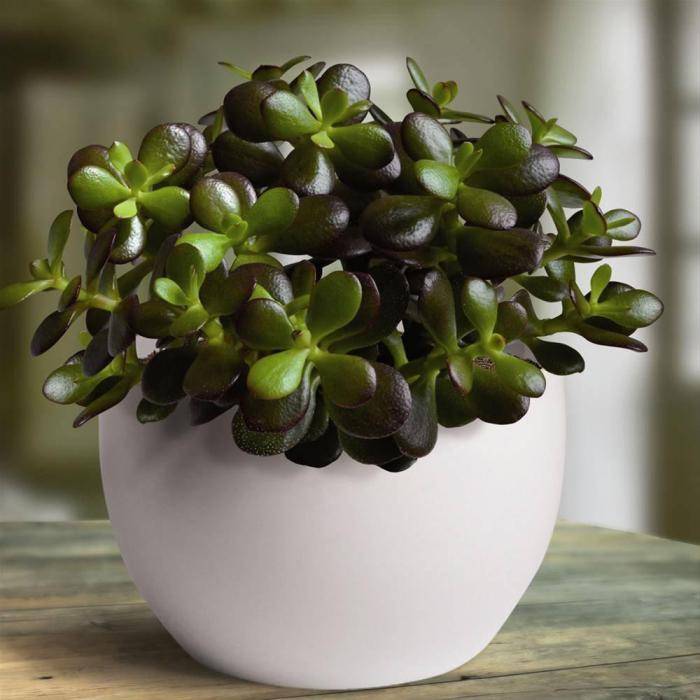

A plant with sturdy stems and interesting fleshy leaves, ideal for those with sunny windowsills or light-colored conservatories. This plant needs at least four hours of sunshine every day, so a sunny windowsill would be ideal. Although the ovate jellyfish is a succulent plant and therefore drought tolerant, it is worth noting that it is not a cactus. Water the plant when you see the soil surface is dry to prevent leaves from falling off. The Fat Woman is a plant that lives for decades and can grow a lot, so try to grow the specimen in a suitable heavy pot to prevent it from tipping over.
Placing flowerpots
In addition to the beauty, plants can create certain inconveniences. To prevent this from happening, they need to be skillfully placed.
- place flowerpots on flat surfaces;
- ampel varieties can be placed on the walls, so they will not interfere with the use of the bathroom or furniture;
- it is not recommended to place flowerpots near the washstand, shower cabins for two main reasons: first, they can be accidentally touched, dumped on the floor, second - not all varieties like direct splashing on the leaves, base or stem;
- you should also not place flowerpots near heating radiators above the window;
- feed with granular fertilizers.
A few tips on how to place the flowerpots, which ones to put where, so that they do not create inconvenience when using.

